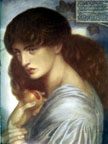One of the grandest and most elaborate portraits of Jane Morris created during the latter part of Rosetti's career, Astarte Syriaca, epitomizes the ideal of the voluptuous, sensual woman -- the muse. After the death of his wife Elizabeth Siddall in 1862, Rosetti returned to the subject matter of the female figure with greater intensity and captured his models with an obsessive sense of sensuality that heralded a novel theme in his work. The painting, Venetian in style as a result of Rosetti's multiculturalism, received mixed criticism due to its strong, often disturbing, erotic content (Rossetti Archive, Astarte Syriaca [for a picture]). Indicative of the nature of his relationship with Jane Morris, Rosetti's treatment of color and feminine subject matter allocates a sense of melancholy within the work, a sentiment that consequently divulges his own tragic love for Jane, the second great muse of his life.
Rosetti renders Jane as Venus Astarte in the painting. Depicted as an icon of desire and sensual perfection, Venus's direct gaze, bare shoulder, and strong stance reveal the strength of her own sexuality. Behind her torch-bearing attendants, a crescent moon shines in symbolic representation of her relation to the cosmos and the divine immortality of her womanly beauty. Rosetti introduces this idea in the first line of the accompanying sonnet of the same name, as he makes an allusion to the figure of the "woman clothed with sun" from the Book of Revelation 12:1, thus revealing his perception of the divine and cosmic power within the beauty of the female (Rossetti Archive). He describes her physical features in an idealized manner that implies the realization of these divine orders upon an encounter with such beauty:
And from her neck's inclining flower-stem lean
Love-Freightened lips and absolute eyes that wean
The pulse of hearts to the spheres' dominant tune.
The image of the spheres here refers to the Pythagorean music of the spheres, and the weaning of the pulse of hearts implies that desire itself can instigate a realization of the cosmic order, the ultimate mystery (Rossetti Archive). Thus, as a composition that references religious iconographic imagery, Astarte Syriaca depicts "the very epitome of the Rossettian Pre-Raphaelite love goddess" (Wood 102) through the idealization of the woman.
Questions
1. In his conclusion of the accompanying sonnet, Rossetti utilizes occult-like diction and imagery to illustrate the divine power of Venus Astarte:
That face, of Love's all penetrative spell
Amulet, talisman and oracle —
Betwixt the sun and moon a mystery.
Comment on the symbolism/typography of these objects, and the additional meaning, if any, that Rossetti's choice of language brings to the painting. Would a Catholic viewer of the time be offended/disturbed by this reference to the occult (especially in regards to sensual love)?



2. Rossetti depicts a very specific image of the woman as a femme fatale, or fair lady, in his latter works, and some of these works do not include any reference to a male figure or masculine point of view that could be wielding influence over the woman subject. Within Astarte Syriaca specifically, Rossetti makes an allusion to the Italian painter Botticelli's The Birth of Venus through the stance of his Venus Astarte, completing the work's Italian influences and erotic undertones. Rossetti portrays similar themes within such later works as Lady Lilith, Proserpine, The Blessed Damozel, Veronica Veronese,and so on. Compare his latter portrayal of the female figure with that of such earlier works as Ecce Ancilla Domini, The Girlhood of Mary Virgin, and even Paolo and Francesca de Rimini. Is there a dichotomy between the female character of the bible or of literature and that of reality?
3. Between the 18th and 19th centuries, attitudes towards women and sexuality changed drastically. Women, once viewed as the most sexual of human beings, were then viewed as sleeping beauties: in order to be sexual, the lover had to awaken their desire. Comment on this painting's relation to such an attitude. Was Rossetti out of tune with the time in his depiction of women?
4. Many of the women he used as subjects during his career seem quite ambiguous, i.e. he painted numerous pictures using the models Elizabeth Siddall, Jane Morris, Maria Stillman, and Alexa Wilding, and it remains difficult to decipher their physical differences by looking at the paintings. Comment on the implications of this ambiguity, and the way in which this idealization reflects upon Rossetti's culture as a whole.
References
McGann, Jerome J., ed. The Rossetti Archive. Accessed October 5 2004. http://jefferson.village.virginia.edu:2020.
Rossetti, D. G. Collected Poetry and Prose. Ed. McGann. Yale UP paperback.
Wood, Christopher. The Pre-Raphaelites. George Weidenfeld and Nicholson: 1981.
Last modified 27 June 2020